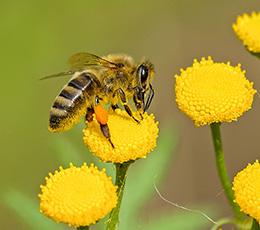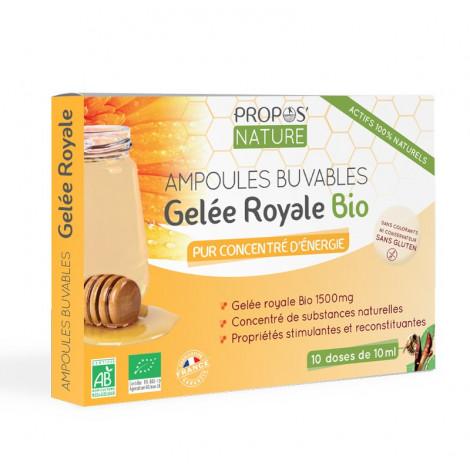On dit souvent que les abeilles sont indispensables à la vie de l’Homme sur Terre, et que si elles venaient à disparaître, nous n’aurions que quatre années à vivre avant que notre écosystème soit entièrement détruit.
Elles représentent à elles seules près de 80% de la pollinisation de notre planète. C’est également grâce aux abeilles que nous pouvons profiter des produits de la ruche, ces concentrés bien-être dont l’être humain bénéficie depuis des millénaires.
Les bienfaits des produits de la ruche sur notre santé, notre bien-être et notre beauté sont des sujets d’actualité qui intéressent de plus en plus ! Découvrons la science qui s'applique à utiliser miel, gelée royale et pollen dans le but d’améliorer notre bien-être au quotidien : l’apithérapie.
What is apitherapy?
Beekeeping is a well-known term, but what about apitherapy? Apitherapy is a method of improving well-being through the benefits of beehive products. The term "apitherapy" comes from the Latin apis, meaning "bee".
In apitherapy, all bee products are used, i.e. products that have been harvested, processed or secreted. The products used in apitherapy are le miel, la propolis, la gelée royale, le pollen, la cire et le venin.
Aujourd’hui, l’apithérapie n’est pas réservée qu’aux apiculteurs mais est reconnue comme médecine douce et fait l’objet d’études scientifiques approfondies visant à isoler les bienfaits spécifiques des différents produits de la ruche sur notre santé.
L’apithérapie peut représenter un outil de choix pour maintenir son bien-être et travailler avec la nature pour agir en préventif et garder la forme !
History of apitherapy
Beekeeping has been around for a long time, and humans have been enjoying the benefits of beehive products ever since they first got close to bees! We could say that apitherapy is just as old as beekeeping, the method of raising bees.
Dans l'Antiquité, de nombreux apiculteurs pratiquaient déjà cette science, notamment avec l’utilisation du venin d’abeille dont on retrouve la mention dans d’anciens textes chinois datant de plus de 2000 ans.
Hippocrate lui-même, aujourd'hui considéré comme étant le père de la médecine moderne, fait à plusieurs reprises mention du venin d’abeille dans ses écrits.

More recently, it was Austrian physician Phillip Terc who brought apitherapy to the forefront with a publication in 1888 detailing his success with the use of bee venom. This apitherapy pioneer later gave way to Charles Mraz, an American beekeeper and therapist who played a major role in the development of apitherapy through his teachings around the world.
Apitherapy took a giant step forward in 1928 when beekeeping specialist Franz Kretchy finalized his method of using bee venom. He succeeded in finalizing a method of injecting bee venom instead of applying it directly to the skin.
Today, numerous associations and groups of professional therapists and beekeepers are actively transmitting their discoveries in apitherapy.
Who practices apitherapy?
L’apithérapie est une méthode bien connue dans le milieu de l’apiculture. Aujourd’hui, il n’existe pas de formation en apithérapie capable d’aboutir à la délivrance d’un diplôme officiel. Il est toutefois possible de se former à l’apithérapie en faisant appel à des organismes et associations proposant régulièrement des formations.
Apiculteurs et praticiens en apithérapie travaillent ensemble pour proposer aux personnes intéressées des mini-formations et ateliers leur permettant de transmettre leurs connaissances et de faire vivre l’art d’utiliser miel, pollen, gelée royale, cire et propolis dans le but de maintenir le bien-être.
On retrouve par exemple les formations de l’association American Apitherapy Society qui met en place chaque année un rassemblement de trois jours visant à la formation des personnes intéressées par l’apithérapie. Il existe en France des formations en ligne qui, même si elles ne délivrent aucune certification, permettent de se familiariser avec l’art de l’apithérapie et d’appliquer ses connaissances à sa pratique professionnelle.
On note d’ailleurs que la branche de l’apithérapie consistant à utiliser le venin de l’abeille connaît un véritable essor à travers le monde. De plus en plus d’intervenants se forment à cette pratique, notamment des médecins, acupuncteurs, naturopathes, homéopathes et apiculteurs.
What are the benefits of apitherapy?
Honey
Super-star du monde de l’apiculture, le miel est bien connu en cuisine pour son goût délicieux ! Mais les avantages du miel ne se limitent pas à cela, ils sont d’ailleurs divers et variés selon la plante d’origine.
Le miel de fenouil est notamment bienfaisant pour la bouche et la gorge. Il présente en effet un effet agréable sur la gorge, sur le pharynx et sur les cordes vocales.
Pour notre beauté, le miel fait des miracles ! Il est recommandé de l’utiliser en masque sur le visage. On peut varier les plaisirs avec le miel de différentes fleurs.
Le miel de lavande est intéressant pour les peaux grasses qu’il permet de rééquilibrer, tandis qu’on préfèrera le miel d’acacia pour les peaux sèches et sensibles.
On applique le masque au miel sur la peau en couche fine et on laisse poser 10 minutes, avant de rincer à l’eau tiède et d’hydrater avec sa crème habituelle.
Pollen
Le pollen (Pollantinum) is an essential in the family of hive products! Depending on its origin and the plant from which it comes, pollen is of particular interest.
Willow pollen, for example, is rich in vitamins B3 and B9, which help reduce fatigue. Cistus pollen is naturally rich in vitamin B2, which also contributes to fatigue reduction and a normal energy metabolism.
Chestnut Bramble helps rebalance and soothe the emotional state, and protects against the harmful effects of stress thanks to its antioxidant potential (ORAC value). It is a source of vitamin B6, which contributes to the normal functioning of your nervous system.
Generally speaking, pollen helps with fatigue. It boosts the body's vitality and resistance.
Royal jelly
La royal jelly, fabriquée par les glandes des abeilles nourricières, est certainement l’un des produits de l’apiculture les plus prisés ! Elle sert à nourrir les larves au sein de la ruche.
Les abeilles destinées à devenir reines se nourrissent exclusivement de gelée royale, tandis que les abeilles travailleuses consomment du nectar, du pollen et du miel.
D’ailleurs, lorsque l’on compare les abeilles travailleuses et la reine, la différence saute aux yeux !
Bien que plutôt blanchâtre et gélatineuse, la gelée royale n’a pas l’air très appétissante, et pourtant, cette substance bienfaisante nous veut beaucoup de bien. La royal jelly contains proteins and B vitamins (B1, B3, B5, B6, B8) as well as vitamins A, C and E.
La gelée royale est également riche en minéraux et oligo-éléments.
Propolis
La propolis (Propolis), aussi appelée “cire noire”, est une résine que les abeilles butinent et que l’on utilise dans certaines crèmes ou compléments alimentaires. Au sein de la ruche, la propolis permet de maintenir une bonne hygiène en prévenant les infections bactériennes.
C’est d’ailleurs à cette fonction protectrice que l’on doit son nom à la propolis : le grec “pro” signifie “devant” et “polis” veut dire “la cité”. La propolis est placée par les abeilles à l’entrée de la ruche pour la protéger, à l’entrée de la cité !
In cosmetics, propolis is interesting in the form of masks or added to creams. It helps maintain clear skin, particularly for people with imperfections such as pimples or oily skin. Propolis-based cosmetics are recommended for regulating excess sebum and restoring clear skin.
Le venin
Il peut sembler bien étrange d’utiliser le venin d’abeille afin de favoriser le bien-être ! En effet, une piqûre d’abeille est synonyme d’inconforts importants et on ferait tout pour l'éviter.
Pourtant, le venin d’abeille est utilisé depuis des millénaires à des fins préventives ou de retour à la forme. Les soins à base de venin d’abeille font partie intégrante de l'apithérapie et leurs usages sont de plus en plus populaires, notamment en Europe et en Asie.
Course of an apitherapy session
Un médecin formé en apithérapie est habilité à pratiquer l’utilisation de venin d’abeille par injection dans le but d’améliorer le bien-être.
Selon la méthode traditionnelle, le venin est administré de manière naturelle par piqûres d’abeilles. Le praticien dépose des abeilles vivantes sur la peau de la personne concernée.
Cette méthode rencontre toutefois une limite importante : dès lors que l’abeille plante son dard dans la peau, elle se détache de la partie supérieure de son abdomen et meurt rapidement.
Aujourd’hui, il est enfin possible d’isoler le venin et de le récolter sans affecter le bien-être de l’abeille. De plus en plus de praticiens travaillent donc par injection de venin à l’aide d’une seringue, méthode plus éthique permettant de profiter de cette branche de l’apithérapie.
Lors d’une séance, la zone de piqûre est choisie de manière très précise selon la localisation de l’inconfort ou sur un point d'acupuncture spécifique. Selon l'objectif de la séance et la situation de la personne qui consulte, un nombre spécifique de séances et une quantité précise de piqûres sont conseillés !
L’apithérapie n’étant pas une méthode scientifiquement reconnue à l’heure actuelle, il n’existe pas de recommandations précises, l’utilisateur se doit de trouver un thérapeute de confiance et expérimenté dans l’art de l’apithérapie afin d’obtenir de bons résultats.
Pour trouver un praticien sérieux, il est recommandé de se tourner vers des associations d’apithérapie reconnues.
Pour une séance d’apithérapie, on peut compter entre 80 et 120 euros selon la renommée du praticien et sa zone géographique.
L'apithérapie consiste en l’utilisation des produits de la ruche dans le but d'améliorer le bien-être. C’est une pratique utilisée de manière informelle depuis des millénaires !
Aujourd’hui, l‘apithérapie fait l’objet de nombreuses recherches, les professionnels en apithérapie, les médecins et les apiculteurs travaillent constamment à la transmission de leurs connaissances afin de rendre l’apithérapie accessible à tous.
À lire aussi : Les bienfaits de la propolis sur la santé




